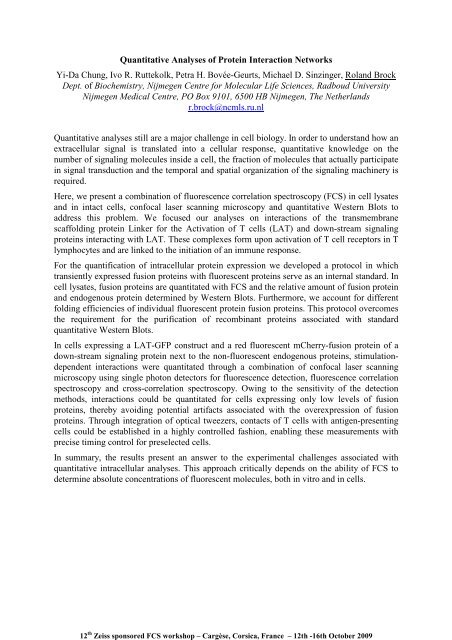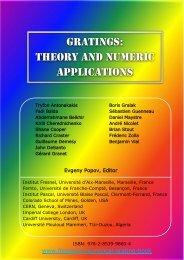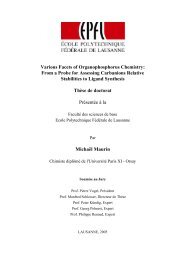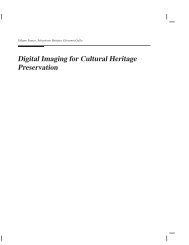12th Carl Zeiss sponsored workshop on ... - Institut Fresnel
12th Carl Zeiss sponsored workshop on ... - Institut Fresnel
12th Carl Zeiss sponsored workshop on ... - Institut Fresnel
You also want an ePaper? Increase the reach of your titles
YUMPU automatically turns print PDFs into web optimized ePapers that Google loves.
Quantitative Analyses of Protein Interacti<strong>on</strong> Networks<br />
Yi-Da<br />
Chung,<br />
Ivo R.<br />
Ruttekolk,<br />
Petra H.<br />
Bovée-Geurts,<br />
Michael D.<br />
Sinzinger,<br />
Roland Brock<br />
Dept. of Biochemistry, Nijmegen Centre for Molecular Life Sciences, Radboud University<br />
Nijmegen Medical Centre, PO Box 9101, 6500 HB Nijmegen, The Netherlands<br />
r.brock@ncmls.ru.nl<br />
Quantitative analyses still are a major challenge in cell biology. In order to understand how an<br />
extracellular signal is translated into a cellular resp<strong>on</strong>se, quantitative knowledge <strong>on</strong> the<br />
number of signaling molecules inside a cell, the fracti<strong>on</strong> of molecules that actually participate<br />
in signal transducti<strong>on</strong> and the temporal and spatial organizati<strong>on</strong> of the signaling machinery is<br />
required.<br />
Here, we present a combinati<strong>on</strong> of fluorescence correlati<strong>on</strong> spectroscopy (FCS) in cell lysates<br />
and in intact cells, c<strong>on</strong>focal laser scanning microscopy and quantitative Western Blots to<br />
address this problem. We focused our analyses <strong>on</strong> interacti<strong>on</strong>s of the transmembrane<br />
scaffolding protein Linker for the Activati<strong>on</strong> of T cells (LAT) and down-stream signaling<br />
proteins interacting with LAT. These complexes form up<strong>on</strong> activati<strong>on</strong> of T cell receptors in T<br />
lymphocytes and are linked to the initiati<strong>on</strong> of an immune resp<strong>on</strong>se.<br />
For the quantificati<strong>on</strong> of intracellular protein expressi<strong>on</strong> we developed a protocol in which<br />
transiently expressed fusi<strong>on</strong> proteins with fluorescent proteins serve as an internal standard. In<br />
cell lysates, fusi<strong>on</strong> proteins are quantitated with FCS and the relative amount of fusi<strong>on</strong> protein<br />
and endogenous protein determined by Western Blots. Furthermore, we account for different<br />
folding efficiencies of individual fluorescent protein fusi<strong>on</strong> proteins. This protocol overcomes<br />
the requirement for the purificati<strong>on</strong> of recombinant proteins associated with standard<br />
quantitative Western Blots.<br />
In cells expressing a LAT-GFP c<strong>on</strong>struct and a red fluorescent mCherry-fusi<strong>on</strong> protein of a<br />
down-stream signaling protein next to the n<strong>on</strong>-fluorescent endogenous proteins, stimulati<strong>on</strong>dependent<br />
interacti<strong>on</strong>s were quantitated through a combinati<strong>on</strong> of c<strong>on</strong>focal laser scanning<br />
microscopy using single phot<strong>on</strong> detectors for fluorescence detecti<strong>on</strong>, fluorescence correlati<strong>on</strong><br />
spectroscopy and cross-correlati<strong>on</strong> spectroscopy. Owing to the sensitivity of the detecti<strong>on</strong><br />
methods, interacti<strong>on</strong>s could be quantitated for cells expressing <strong>on</strong>ly low levels of fusi<strong>on</strong><br />
proteins, thereby avoiding potential artifacts associated with the overexpressi<strong>on</strong> of fusi<strong>on</strong><br />
proteins. Through integrati<strong>on</strong> of optical tweezers, c<strong>on</strong>tacts of T cells with antigen-presenting<br />
cells could be established in a highly c<strong>on</strong>trolled fashi<strong>on</strong>, enabling these measurements with<br />
precise timing c<strong>on</strong>trol for preselected cells.<br />
In summary, the results present an answer to the experimental challenges associated with<br />
quantitative intracellular analyses. This approach critically depends <strong>on</strong> the ability of FCS to<br />
determine absolute c<strong>on</strong>centrati<strong>on</strong>s of fluorescent molecules, both in vitro and in cells.<br />
12 th <str<strong>on</strong>g>Zeiss</str<strong>on</strong>g> <str<strong>on</strong>g>sp<strong>on</strong>sored</str<strong>on</strong>g> FCS <str<strong>on</strong>g>workshop</str<strong>on</strong>g> – Cargèse, Corsica, France – <str<strong>on</strong>g>12th</str<strong>on</strong>g> -16th October 2009













